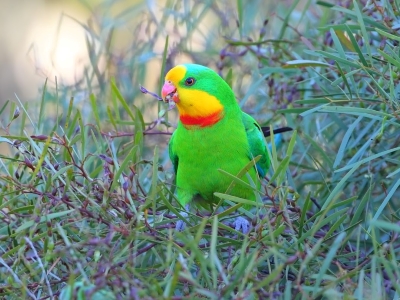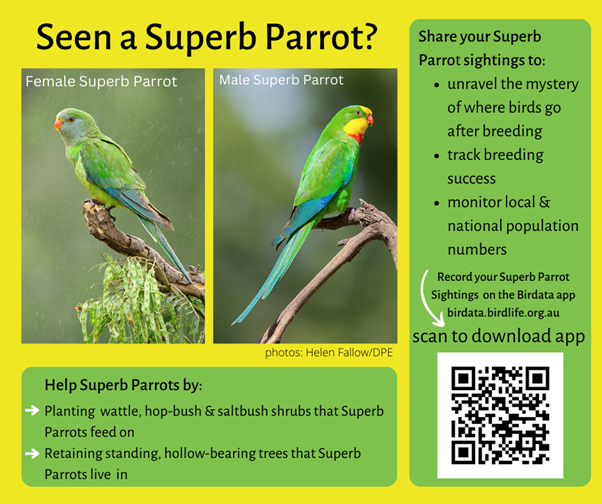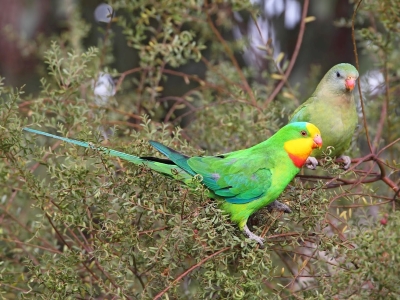Restoring Superb Parrot Flyways
The Restoring Superb Parrot Flyways project set out to restore superb parrot foraging habitat in the Mulwala-Savernake district of the NSW Murray region.

ABOUT THE SUPERB PARROT
The superb parrot is a large, attractive parrot with a distinctive yellow neck and forehead and an orange blaze under the chin.
In the Murray region, it nests between September and January in River Red Gum tree hollows along the Murray and Edward/Kolety Rivers. Over the nesting period, flocks of males feed together and travel to and from foraging sites, where they collect food for the brooding females. Foraging sites are usually within 10km of the nest site. Males may make 2-3 flights each day from nests to foraging areas and back, during which time the females do not leave the nest other than to be fed by the male.
Throughout the rest of the year, Superb Parrots forage in the surrounding grassy box woodland, White Cypress Pine woodland, Boree woodlands and grasslands of the Riverine Plains, away from the major rivers. Most of the foraging habitat is on private land. Superb Parrots feed mainly on the ground and sometimes in trees and shrubs. They eat the seeds of grasses and plants, fruits and berries, nectar, flowers and some insects.
The Superb Parrot has suffered a decline in range and abundance over the last 100 years. The Superb Parrot (Polytelis swainsonii) is listed as vulnerable in NSW and Australia. Fewer than 5,000 – 10,000 birds remain in the wild.
Major threats include clearing and degradation of nesting and foraging habitats, disturbance around nesting sites, competition for nest hollows, trapping for the pet trade and road kill.
WHAT DID THE PROJECT DO FOR SUPERB PARROTS?
This project staff worked with landholders to restore foraging habitat and flyways for Superb Parrots by:
- protecting remnants containing hollow-bearing trees by fencing and excluding grazing stock;
- planting and direct seeding of known food plants for superb parrots, such as Gold-dust Wattle, Silver Wattle, Deane’s Wattle, Wallaby Grass, Wedge-leaf Hopbush, Creeping Saltbush; and
- creating revegetation flyways to improve connectivity between foraging and breeding habitat, including paddock trees with hollows where possible.
WHAT CAN YOU DO TO HELP SUPERB PARROTS?
- Retain and protect woodland remnants.
- Plant native trees, shrubs and grasses for habitat and feeding.
- Prevent grain spills and watch out for superb parrots feeding along roads.
- Report suspected illegal bird trapping, egg collection or sales to NPWS.
- Ensure that hazard reduction burns and stubble burns avoid damaging large hollow-bearing trees that provide Superb Parrot breeding habitat.
- Share your superb parrot sightings with Birdlife Australia's Birdata app

PROJECT ACHIEVEMENTS
From 2020 to 2023, with funding support from the NSW Environmental Trust, Superb Parrot Project participants have:
- Established 4 conservation agreements
- Completed 5.6 km of fencing
- Planted approximately 50 ha of trees, shrubs and groundcovers for Superb Parrot foraging habitat
- Attended two community workshops (82 attendees)
- Supported the ‘Seedlings for Superbs’ giveaways (60 participants)
MORE INFORMATION
If you wish to know more about superb parrots, please don't hesitate to get in touch with:
- Lou Bull on 0436 316 432 or lou.bull@lls.nsw.gov.au
- Shanna Rogers on 0457 733 261 or shanna.rogers@lls.nsw.gov.au
For more detailed information on the superb parrot, please visit the NSW Government’s superb parrot profile or download the Superb Parrot Information Booklet.
Murray Local Land Services support this project through funding from the NSW Government's Environmental Trust.
